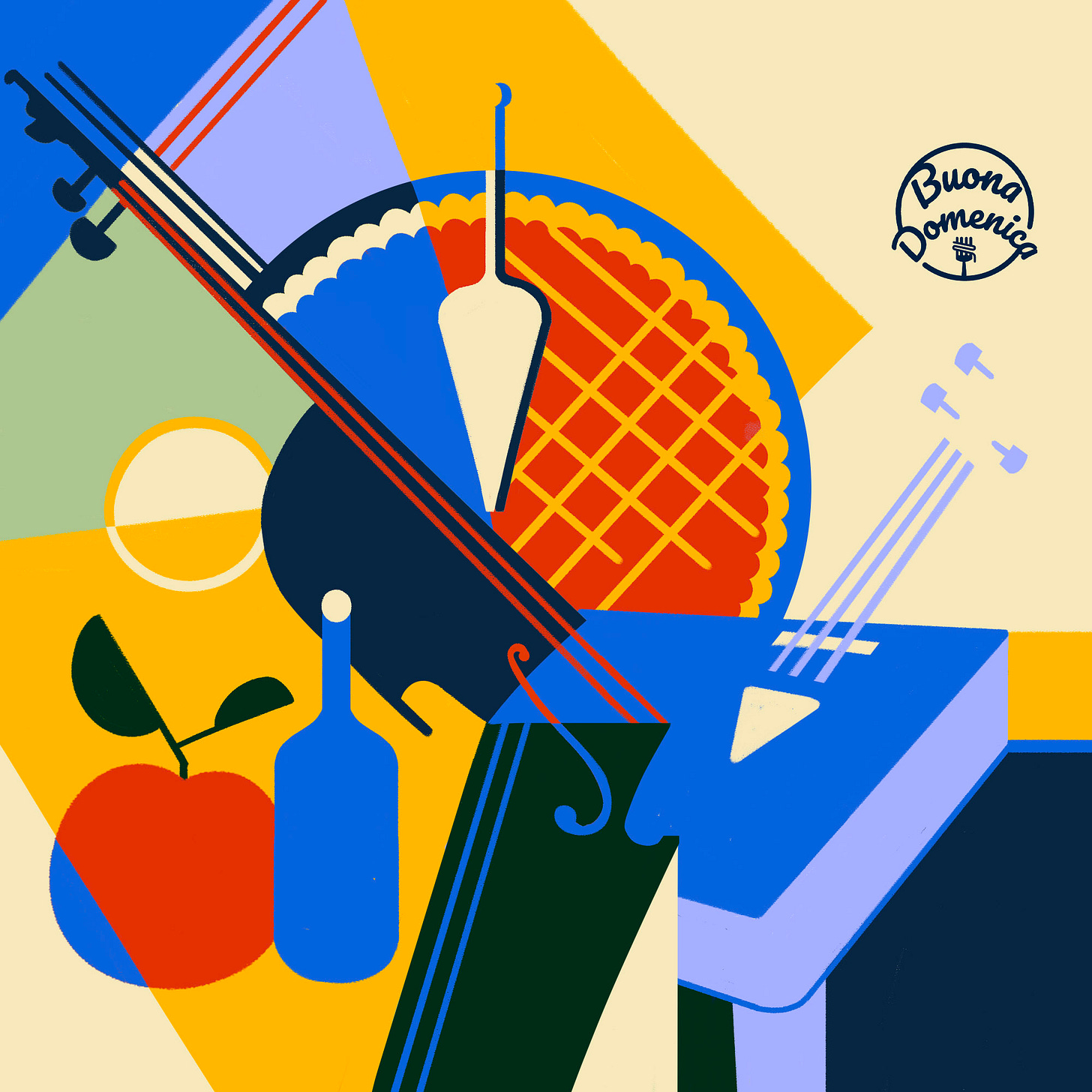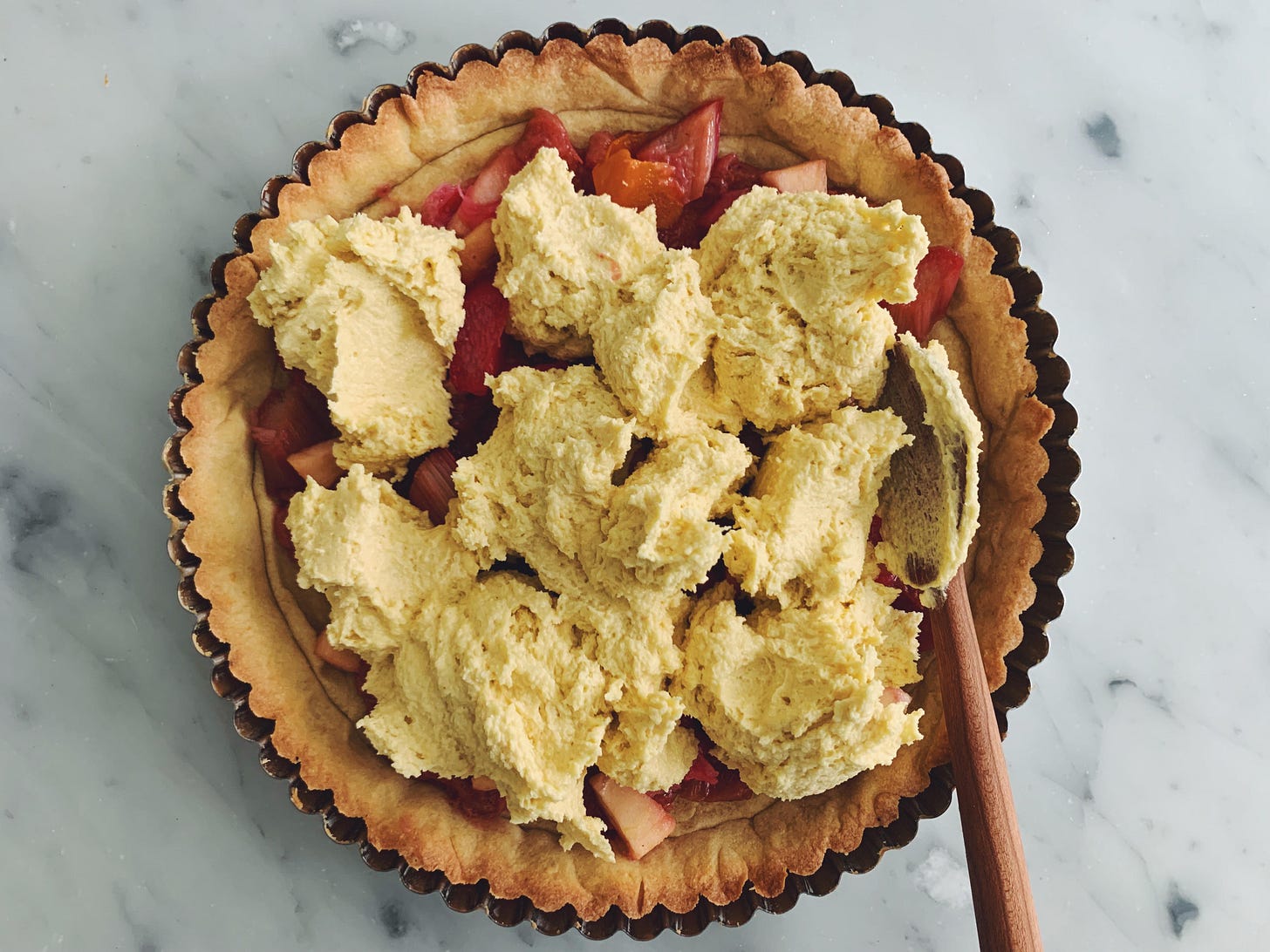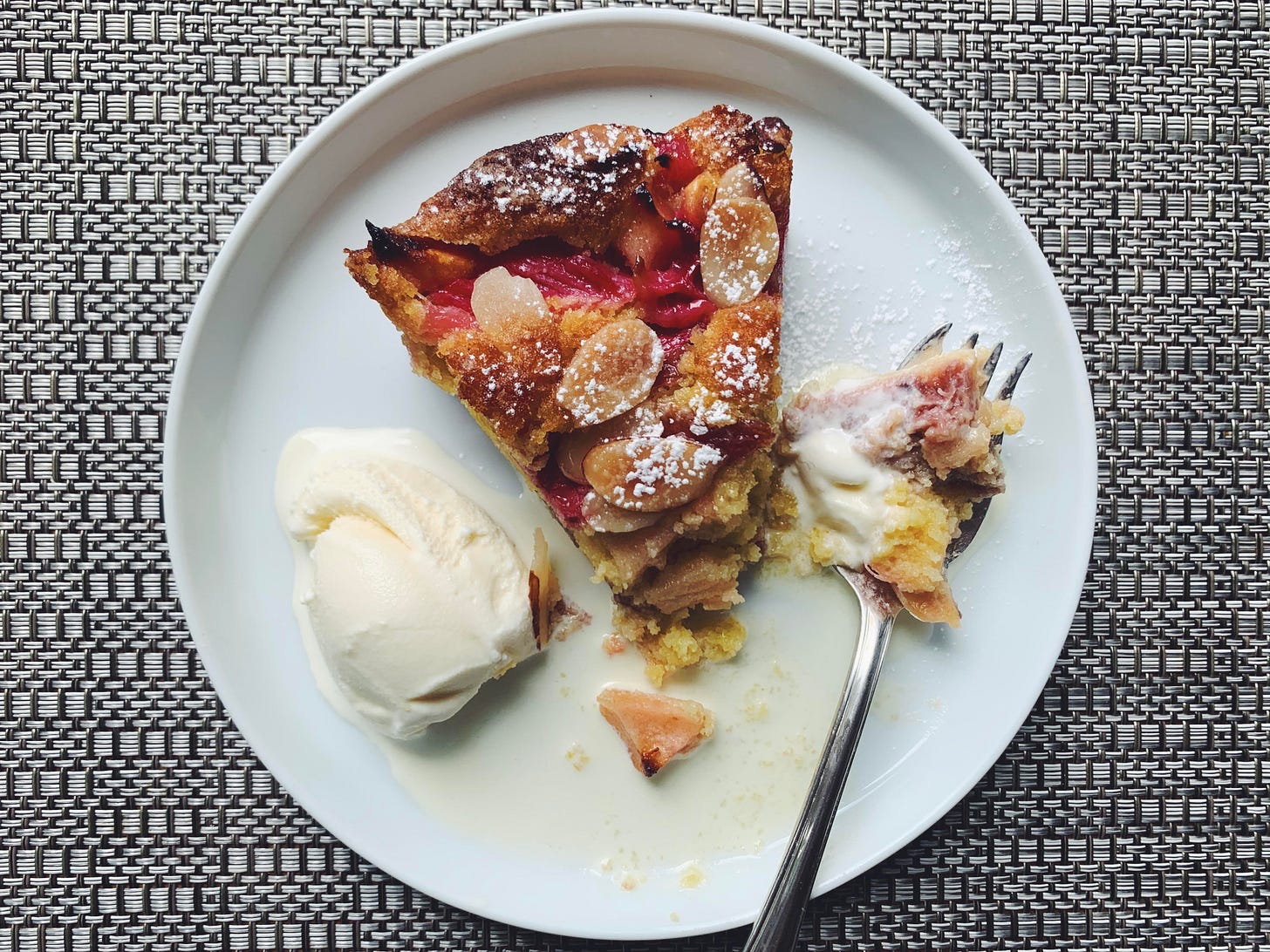An Anglo-Italian-American Mashup
Improvisation in the kitchen and a recipe for Rhub-Apple Frangipane Crostata

Welcome to Buona Domenica, a weekly newsletter of Italian home cooking and baking. I’m a journalist, cooking teacher, occasional tour guide, and author of eight cookbooks on Italian cuisine.
Happy Mother’s Day to all the mamas out there. As a gift to you, I’ve written a newsletter that has nothing to do with Mother’s Day, though the recipe would certainly make a fine dessert to celebrate the occasion. And, for a good laugh, feel free to go back and look at last year’s Mother’s Day post.
Quick update on my Spring 2025 small-group tour: I will be (finally) be sharing dates and details in my next newsletter, which will publish on Sunday, May 25 (Daniela and I are taking a short break next week).
In the mean time, for those of you who are interested in honing your drawing skills or just want to learn the basics of sketching, check out Danielle Oteri’s October workshop-tour in southern Italy featuring New York-based illustrator Jenny Kroik. Jenny’s work has appeared in various publications, including cover art for The New Yorker. Danielle offers tours in southern Italy and also writes the newsletter
here on Substack.This week’s newsletter features a recipe for Rhub-Apple Frangipane Crostata for paid subscribers and a link to a recipe that served as its inspiration for all subscribers.
Click here to browse through the newsletter archive. If you’re looking for a particular recipe, you’ll find all Buona Domenica recipes—157 and counting—indexed here, ready to download and print—a function for paid subscribers. Although many recipes are initially free when I publish them here, they do go behind a paywall after a few weeks.
If you are able to do so, please consider supporting my work by becoming a paid subscriber.
On to this week’s newsletter…
My grandpa was a fiddler. I have a sliver of a memory of him playing his violin and singing “Skip to My Lou,” though it is entirely possible that what I am remembering is my dad talking about my grandpa playing his fiddle and singing “Skip to My Lou.”
I say fiddler, but in reality, Domenico Marchetti (my namesake!) was a classical violinist, having studied under a former conductor of the Rhode Island Philharmonic Orchestra in the early decades of the 20th Century. In the 1920s, he had his own orchestral and chamber music group. This was something he did on his own outside of his job working for a funeral home in Cranston, R.I., which he did for 50 years. How someone who came to the U.S. at age 12 from the impoverished region of Molise (or one half of gli Abruzzi, as it was known back then) ended up an accomplished violinist, I wish I knew. I’m sorry to say, I never asked.
When I started playing violin in fourth grade at my elementary school, Grandpa gave me his fiddle. It was too big for me then, so I played with a downsized instrument that my parents bought through the school, but I loved taking my grandfather’s out of its case and admiring it (I still have it).
I squawked and scratched my way through violin lessons for three years, but they ended when I transferred to a school that did not offer them. This was all for the best, as I was, admittedly, not good at it. Whatever the opposite of “prodigy” is, that was me playing the violin.
And yet, it turns out I am a fiddler after all. Except that instead of strings and a horsehair bow, I fiddle with ingredients and recipes. I’ve mentioned before that I am forever tweaking recipes (mine and others’), but it’s not really about a quest for perfection. Yes, I want to share the best possible versions of the recipes that I create, but I also tweak because it’s fun and interesting and keeps life in the kitchen exciting. It’s an improvisation of sorts. For example, I make vegetable soup a lot, but I never make it the same way twice—unless I am testing a recipe for publication. My most recent iteration contained farro, chick peas, a baby Savoy cabbage (shredded), and a fennel bulb, a combination I don’t think I had put together before and that turned out to be really satisfying. I wrote a rough recipe for it here:
Recipes that claim to be “the best recipe” or “the only recipe you’ll ever need” for chocolate cake or roast chicken or ragù alla Bolognese irritate me. I realize this language is click bait, and that those who approach cooking or baking with trepidation might find comfort or even confidence in those words. But I am turned off by the static nature implied in them, as though you, the cook, have no agency or initiative or imagination. Cooking is never static; it is always evolving, along with our tastes. Even baking, which generally requires more precision than cooking, leaves some room for improvisation and creativity.
Not long ago, I pulled my grandpa’s violin out of the storage room, where it had rested, unopened, for many decades. The horse hairs had sprung free from the bow frame and were lying about in a kinky tangle in the case, as though they were angry that they had been confined and neglected for so long.
Which brings me to this week’s recipe, a dessert that started out as a classic British Bakewell tart and with some fiddling has now been transformed into an Anglo-Italian-American rhubarb-apple frangipane crostata. I’ve even created my own portmanteau for it: “Rhub-Apple.”
Violins are meant to be played; recipes are meant to be played with.
The recipe for Rhubarb Bakewell Tart can be found here.
Readers: What kind of a cook or baker are you? Do you like to follow a recipe to the letter, or are you a fiddler like me?
If you enjoy Buona Domenica, please do me a small favor and click on the little heart icon at the top of this post, and share it with the Italian food lovers in your life. These gestures help to spread the word about this newsletter. And to keep up with my daily goings on in the kitchen, follow me on Instagram.
RECIPE: Rhub-Apple Frangipane Crostata
If you are a devotee of the Great British Bake Off, as I am, you might be familiar with Bakewell tart, as contestants are sometimes asked to bake their own version during the competition. It features a short cut (fat-rich) pastry spread with jam and topped with frangipane, a thick batter made with ground almonds, sugar, and eggs.
Keep reading with a 7-day free trial
Subscribe to Buona Domenica to keep reading this post and get 7 days of free access to the full post archives.






